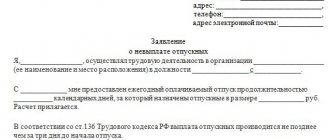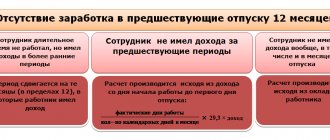Vacation pay calculator
How to use the calculator?
- Enter the start and end dates of your vacation. Take the first one from the employee’s application, choose the second one yourself. Make sure that the number of vacation days matches the number on the application. Holidays are not counted as vacation days, so vacation according to the calendar may be longer.
- The billing period will be determined automatically. Add exception periods if there are any - these are vacations, sick leave, business trips or absences from work for other reasons. If during the billing period you massively increased the salaries of all employees of the organization or department, check the box. It is not needed if the salary of only one or several employees was increased.
- Go to the next step and indicate payments to the employee for the payroll period. This is a salary with allowances and bonuses, which are taken into account according to the rules from paragraph 15 of the Government Decree. Do not take into account vacation pay, sick leave, business trips and other payments based on average earnings, as well as financial assistance and compensation for food expenses.
- At the last step, look at the amount of vacation pay and personal income tax. An article about what documents to use to apply for a vacation
What taxes do you need to pay?
According to the Labor Code of the Russian Federation, if the vacation is paid for by the employer, the amount of vacation pay is subject to taxes. Personal income tax - 13% for residents of the Russian Federation and 30% for non-residents - is withheld on the day of payment of vacation pay. The deadline for tax remittance is set for the last day of the month in which the employee’s vacation was paid.
Personal income tax
In addition, insurance premiums must be paid from vacation pay. They are accrued for the same reporting period as vacation pay and transferred to the budget no later than the 15th day of the next month.
Letter of the Ministry of Labor dated August 12, 2015 No. 17-4/OOG-1158
Number of vacation days
An employee is entitled to paid leave of 28 calendar days for each working year worked (vacation period).
The vacation period starts counting from the date the employee is hired. As a rule, he needs to work for you for at least six months before going on vacation. But at the request of the employee, you can allow him to take leave earlier.
The vacation period includes all the time when the employee retained his place of work (position), including weekends and holidays, vacation days, sick leave, etc.
The length of leave for leave does not include the time of absence from work without good reason, including the time an employee is removed from work due to his fault, as well as the time of parental leave and leave without pay for more than 14 days per year. Days excluded from the vacation period shift the end of the employee’s working year.
The number of vacation days for a part-time working year is calculated using the formula::
The number of vacation days due to an employee for a full year / 12 months x Number of months worked.
Months worked are counted in the same way as the working year, from the date of hire.
Months not fully worked are taken into account as follows:
- a month is counted as fully worked if the employee worked half the month or more
- a month is not taken into account in the calculation if the employee worked less than half a month.
If an employee has accumulated vacation days for the past year, you can provide them as you like - in parts or combined with vacation for the current year.
Working part-time does not affect the calculation of vacation experience in any way.
Example: Dasha was hired on July 2, 2021. Since by the time the vacation starts on May 12, 2021, Dasha has not fully worked the working year, let’s calculate the number of vacation days for the incomplete working year:
- the months from July to December 2021 and from January to April 2021 have been fully worked out, 10 in total
- May 2021 has not been fully worked out, less than half a month, we do not take it into account.
Dasha worked fully for 10 months, for a full year she would have been entitled to 28 days of vacation, which means for an incomplete year: 28/12 x 10 = 23.
Salary based on salary: documentation when calculating on a calculator
In order for an accountant to determine how to calculate wages based on salary, he needs to have the following data:
- An order to hire a specialist with a salary in accordance with the staffing table. Since the Labor Code of the Russian Federation contains a reference to the staffing table, often when checking by the labor inspectorate, the absence of this document is regarded as a violation.
- The official salary established for a given employee, the fixed amount of which is determined by an employment or collective agreement.
- The number of days worked by an employee in a calendar month is documented in a time sheet. The unified form of this document is mandatory for public sector organizations and approved by Order of the Ministry of Finance of Russia dated March 30, 2015 No. 52n, for other business entities unified forms, incl. the work time sheet (form T-13) and the work time sheet and calculation of wages (form T-12) are not mandatory for use (Law “On Accounting” No. 402-FZ of December 6, 2011). If an organization that is not a government organization decides not to use unified forms, it enshrines in its local regulations independently developed forms of documents for recording working hours.
When paying for the month worked, the employee must provide a pay slip, the form, procedure and frequency of submission of which the organization develops independently.
Billing period
This is 12 calendar months before the vacation. It depends on when the employee’s vacation actually begins. It does not matter for what period (working year) it was provided. If the employee has not yet worked 12 months, then the billing period is the time during which he is employed by you.
If an employee takes vacation from May 14, 2021, then the calculation period is from May 1, 2021 to April 30, 2021.
If the entire billing period falls on maternity leave or parental leave, replace it with the previous 12 months. If the billing period falls partly on maternity leave, do not change anything.
The number of days worked in the billing period is all working days, weekends and holidays while the employee was under an employment contract. Exclude business trips, vacations, sick leave or absences from work for other reasons.
The number of days in a month that is fully worked is always the same - 29.3.
Calculate the days in an incompletely worked month using the formula:
Number of days worked in a month / Number of calendar days in a month x 29.3.
Even weekends and holidays are considered days worked. Only discount those that fall during exclusion periods.
Example:
Dasha is going on vacation on May 12, 2021. During the billing period from May 1 to April 30, there were exception periods:
- business trip - from June 6 to June 11,
- annual paid leave - from August 14 to August 25.
Dasha worked completely for 10 months. Number of days = 29.3 x 10 = 293 days.
Let's count the number of days in June and August that Dasha did not work fully.
- In June = 24/30 x 29.3 = 23.44
- In August = 19/31 x 29.3 = 17.96
Days worked during the billing period: 293 + 23.44 + 17.96 = 334.4
Features for individual categories
Not all citizens are employed for a long time. There are persons who enter into fixed-term employment agreements or civil law contracts (GPC). About the latter, it must be said that they do not have the right to paid days off at the expense of the employer, since there are no labor relations formalized by law.
As for persons working under fixed-term contracts for a period of up to 2 months, then, according to Art. 291 of the Labor Code of the Russian Federation, they have the right to receive 2 paid days for each month of work. According to Art. 295 of the Labor Code of the Russian Federation, citizens performing seasonal work under an employment agreement have a similar right. Employees with whom the employment contract is concluded for a period of up to 11 months can exchange rest for compensation. But they will receive it only upon dismissal.
Some workers also have the right to extended rest periods. These include minors (minimum term - 31 days), disabled people (30 days), teachers (42 or 56 days - based on Government Decree No. 466 of May 14, 2015), judges (30 days), state and municipal employees (30 days ), law enforcement officers (30 days).
Average daily earnings
Let's calculate it using the formula:
Payments in the billing period / Number of days worked during the same time.
Take into account the salary with all allowances and coefficients, and bonuses according to the rules from paragraph 15 of the Government Decree.
Do not take into account vacation pay, travel allowance, sick leave and other payments that are calculated based on average earnings, financial assistance, and compensation for food expenses.
If during the billing period you massively increased salaries in an organization, branch or division, index the average employee’s earnings according to the rules from paragraph 16 of the Regulations.
Divide the received payment amount by the number of days worked.
There is a separate article on calculating average daily earnings.
Example:
Dasha received 40 thousand rubles a month throughout the entire billing period.
Vacation pay base for the billing period = 40,000 x 12 = 480 thousand.
Average daily earnings = 480 thousand / 334.4 = 1435.41 rubles.
Amount of vacation pay = Average daily earnings x Number of vacation days = 1435.41 x 17 = 24,401.97.










